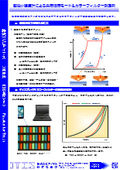Total solution for the reliability of liquid crystal displays.
We provide comprehensive support for customers facing reliability issues with overseas manufactured LCD displays, from reliability testing to failure analysis and material analysis.
Unreliable LCD displays are causing problems in the market. At Aites, we solve our customers' reliability issues through our extensive experience and state-of-the-art equipment, conducting reliability test design and visual inspections before and after testing. Furthermore, we provide support from failure mode classification to failure analysis and material analysis.
basic information
■Reliability Testing of LCD Products Extensive testing menu Visual inspection before and after testing Reducing the burden on customers ■Failure Analysis of LCD Products Unique correlation of failure modes, related areas, analysis targets, and main methods Achieving rapid and accurate analysis
Price information
We will provide a quotation based on your request.
Delivery Time
Applications/Examples of results
- TFT characteristics, TFT structure, TFT foreign substances - Driver IC connection parts, wiring corrosion, surface contamination - Microscopic foreign substances, liquid crystal contamination, alignment film contamination - LED failure, PCB failure, polarizer and sheet foreign substances - Seal, sealant degradation
catalog(26)
Download All Catalogs
News about this product(3)
-

In-chamber imaging during constant temperature and humidity testing.
Our company conducts environmental testing using a constant temperature and humidity chamber with a front glass window and a camera, allowing us to capture and monitor the operational status, such as screen displays, during the tests. During environmental testing using equipment like constant temperature and humidity chambers, monitoring the condition of the test subjects with loggers (for voltage, current, resistance, temperature, etc.) is widely practiced. However, monitoring the operational status of equipment during testing can be difficult unless the test equipment is equipped with dedicated external outputs. For samples where monitoring with loggers is challenging, we combine a constant temperature and humidity chamber with a front glass window option, a camera, and monitoring software to conduct environmental tests while capturing and monitoring the condition of the test equipment.
-

Analysis of trace metal elements in liquid crystals
We will introduce a case where ICP measurement was conducted using panels before and after reliability testing, along with quantification. The liquid crystal molecules in an LCD are oriented within the panel, and the display is controlled by changes in the orientation state of the liquid crystal due to voltage. When ionic substances, such as metal elements, are present inside the panel, the liquid crystal may not drive correctly, leading to display defects. It is known that ionic substances can increase due to contamination during manufacturing or long-term use, making it important to quantify and understand them as part of panel quality. Metal ions can be quantitatively analyzed using ICP analysis, and depending on the differences in pretreatment methods and detection sensitivity, ICP-AES and ICP-MS are used selectively. [Analysis Content] ■ Comparison of metal element content using ICP-AES analysis ■ Comparison of metal element content using ICP-MS analysis For more details, please refer to the related products and catalog below.
-

Analysis of LCD Display Materials
Liquid crystal displays use various organic materials, including liquid crystals, sealing materials, encapsulants, and polarizers. Considering the material properties and degradation mechanisms of each component from a chemical perspective is important for product evaluation and failure analysis. This document presents examples of chemical analyses for the components of liquid crystal displays. 【Examples of Chemical Analysis】 ■FT-IR: Principal component analysis ■EDX: Elemental analysis ■GCMS: Liquid crystal component analysis ■HS-GCMS: Outgassing analysis (degradation analysis) and others
Recommended products
Distributors
Aites was established in 1993, originating from the quality assurance department of the IBM Japan Yasu office. Based on the technical expertise cultivated through cutting-edge defect analysis and reliability assurance of electronic components at the IBM Japan Yasu office, we have provided various products and services that support the development and manufacturing of semiconductors, displays, organic EL, solar cells, and electronic components to customers both domestically and internationally.












































































